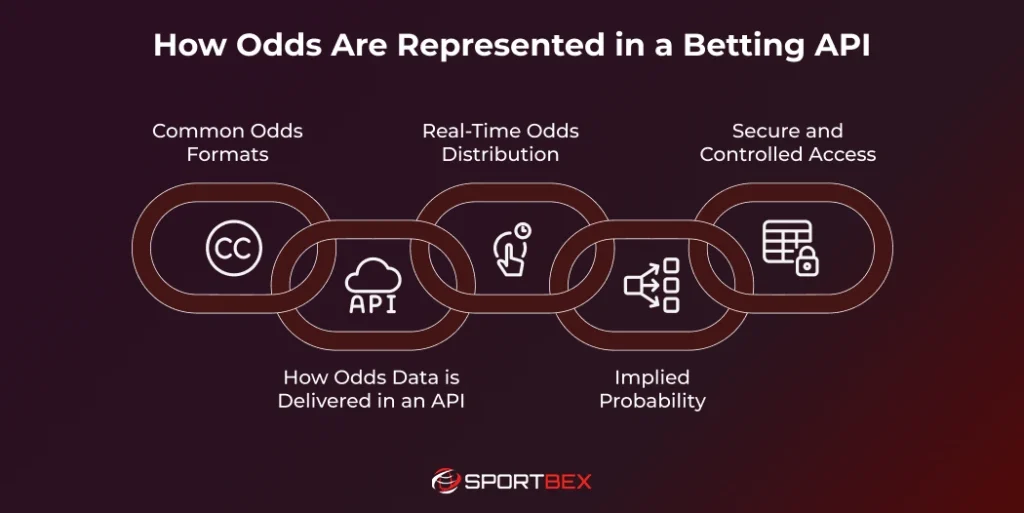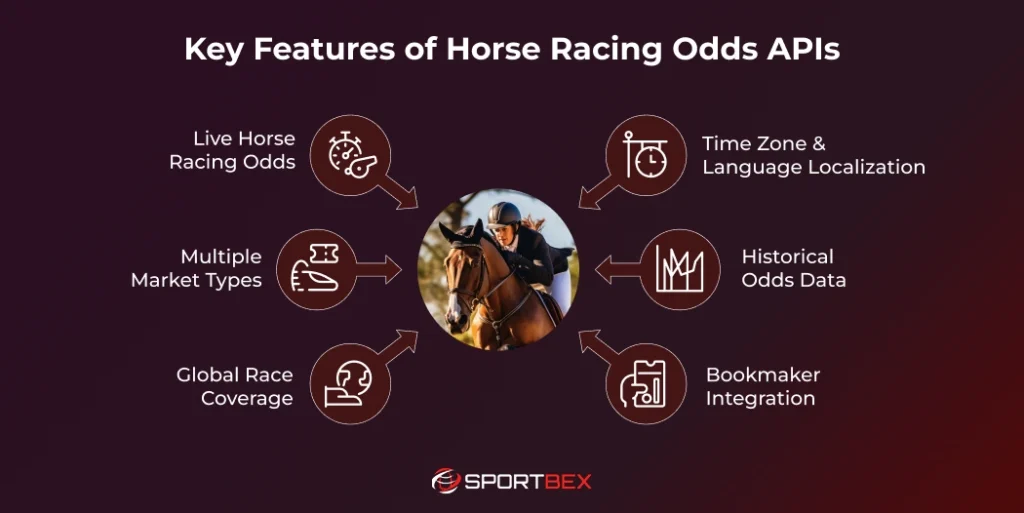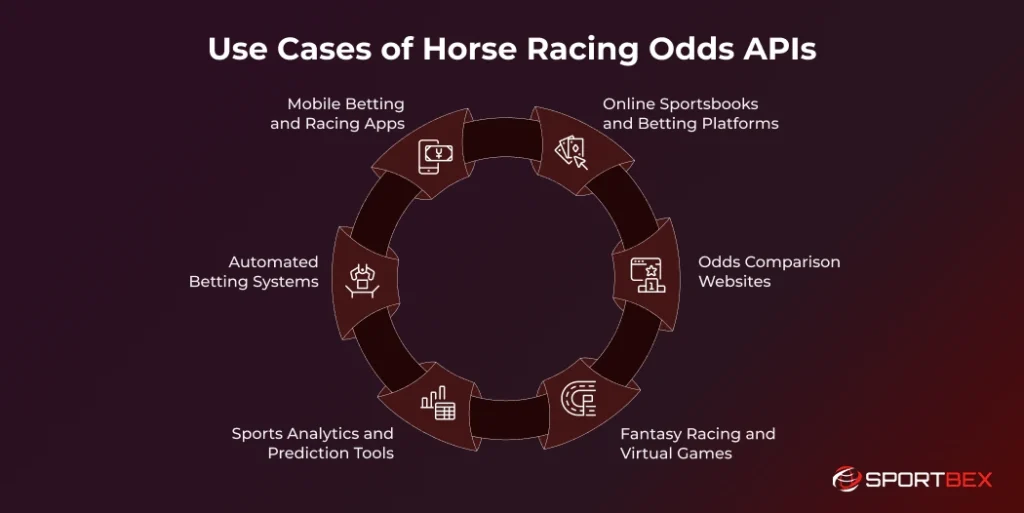Horse racing is fast, thrilling, and packed with action. Betting makes it even more exciting, but there’s one key thing behind every bet: the odds. These odds aren’t random; they’re carefully calculated and updated in real time based on factors like horse performance and betting activity.
But how do those odds get from the racetrack to your betting app so quickly? The answer lies in the horse racing API. These tools connect betting platforms to live data feeds, delivering accurate, real-time odds to users in seconds.
In this blog, we’ll break down how horse racing odds work in a betting API. You’ll learn also how the odds are calculated, how they’re shared through the API, and why betting platforms depend on them.
What Are Horse Racing Odds?
Horse racing odds are numbers that represent two important pieces of information:
- How likely is that horse to win the race?
- How much money could you win if you bet on that horse?
When you examine the odds presented, you are considering a prediction and a potential payout. A sportsbook establishes the odds and can change them before race time, based on how the horse has run in the past, the weather, and how the public is betting.
Types of Horse Racing Odds
There are a few different ways that odds can be shown. Here’s how to read each type:
- Fractional Odds: This is common in the UK. Using a UK racing odds API it means you’ll win $5 for every $1 you bet.
- Decimal Odds: Popular in Europe and Australia, decimal odds like 6.00 or 2.50 represent the total return, including the original stake.
- Moneyline Odds: These are mostly used in the U.S. A +500 means you win $500 on a $100 bet.
How Horse Racing Odds Are Calculated
Horse racing odds are calculated based on how likely a horse is to win a race. If a horse is likely to win, the horse has lower odds, and the payout will also be lower. If the horse is less likely to win, the horse has higher odds, and the payout will be higher.
Several factors are considered when odds are calculated. These include:
- The horse’s past performance
- The jockey’s track record
- Track conditions
- The amount of money being bet on each horse
In most cases, odds are set by bookmakers and adjusted as more bets come in. This process is often handled by automated systems or algorithms, so the odds can change in real time.
This way, the odds are always updated to reflect the latest betting activity and race information.
How Odds Are Represented in a Betting API

Adding horse racing odds to sports betting APIs requires planning. You need to consider how the odds are formatted, how often the data is updated, and how to make it work across different countries.
This guide breaks down how odds formats work, what you’ll need technically, and tips for creating APIs that are fast and reliable. Horse racing odds are sent through an API in a way that computers can easily read. The API shares all the needed details, like race time, horse names, and odds, in a clear and organized format.
Common Odds Formats
Different areas of the world present betting odds differently. A good API should support all the main types:
- Fractional Odds (like 5/1): This means you win $5 for every $1 you bet, plus you get your $1 back. Common in the UK.
- Decimal Odds (like 6.00): This shows the total amount you’ll get back, including your bet. So a $1 bet at 6.00 gives you $6. Popular in Europe and Australia.
- Moneyline Odds (like +500): Used in the U.S. This means you win $500 for every $100 you bet.
Most good APIs will give odds in all three formats, or let you choose the one that works best for your users.
How Odds Data is Delivered in an API
Adding horse racing odds to sports betting APIs requires planning. You need to consider how the odds are formatted, how often the data is updated, and how to make it work across different countries.
This guide breaks down how odds formats work, what you’ll need technically, and tips for creating APIs that are fast and reliable. Horse racing data, including odds, is sent through an API in a way that computers can easily read. The API shares all the needed details, like race time, horse names, and odds, in a clear and organized format.
Apps and websites use this information to show live odds to users. The data updates automatically, so the odds are always current. This helps platforms stay fast, accurate, and easy to use without needing to update things by hand.
Real-Time Odds Distribution
Odds need to be updated constantly, especially during live events or close to race time when betting activity increases. A reliable sports betting API will:
- Refresh odds every few seconds
- Support push notifications or webhooks to alert platforms when odds change
- Provide tools to handle sudden changes, such as a horse being withdrawn or odds shortening sharply
Real-time distribution is important to prevent bettors from making decisions based on outdated information. It also helps sportsbooks avoid financial risk from large bets placed after odds have changed.
Implied Probability
Odds show how much you could win, but they also tell you how likely a horse is to win. This is called implied probability.
Here’s a quick trick to find it:
- Take 1 ÷ decimal odds
- Example: If odds are 4.00 → 1 ÷ 4.00 = 0.25 = 25% chance to win
Bookmakers adjust these odds slightly to make sure they earn a profit. APIs sometimes include this probability so users and platforms can see the logic behind the odds.
Secure and Controlled Access
Because betting data is sensitive and valuable, security and access control are essential.
Most horse odds APIs use:
- API Keys or tokens: To identify and limit who can use the service
- Rate limits: To prevent overloading the system (e.g., 100 requests per minute)
- Authentication systems: Like OAuth or bearer tokens, to keep data secure
This ensures the horse racing data feed is protected, the service stays stable, and only authorized platforms can use the odds feed.
Everything You Need for Horse Racing
Access live results, racecards, betting odds, and historical data with one API.
Key Features of Horse Racing Odds APIs

Horse racing odds APIs are designed to deliver real-time betting odds and market data from horse races happening around the world. These APIs are a must-have for betting websites, fantasy apps, and sports data platforms.
Here are the most important features you’ll find in a horse racing odds API:
Live Horse Racing Odds
One of the most important features of these live horse racing odds APIs is the ability to provide live odds. This means Live Horse Racing Odds are constantly updated as new information comes in, such as more bets being placed or a horse being withdrawn.
Live updates are especially useful for in-play or real-time betting, where every second counts. Users always see the latest odds without needing to refresh the page.
Multiple Market Types
A good horse racing odds API supports a wide variety of betting options. This includes not just “win” bets, but also bets like Place, Show, Exacta, Trifecta, and Each-Way.
These extra betting types give users more ways to play and make the platform more exciting. It also helps websites and apps cater to more experienced bettors who want more than just the basics.
Global Race Coverage
Top-tier APIs don’t just focus on one country; they provide data for races all over the world.
Whether it’s the Kentucky Derby in the U.S., Royal Ascot in the U.K., or local horse races in Australia or South Africa, a global feed lets users follow and bet on races happening in any time zone. This makes the platform more appealing to international audiences.
Time Zone & Language Localization
A quality API makes sure the data can be easily understood by users from different countries. It adjusts race times to the user’s local time zone and supports multiple languages.
Odds can also be displayed in the format people are most familiar with, like decimal, fractional, or moneyline. This creates a smoother, more personalized experience for users around the world.
Historical Odds Data
Some APIs also provide historical data, which is great for people who want to study trends or develop prediction models. This means you can see how odds moved before a race or compare past performances of horses and jockeys.
It’s especially helpful for developers creating tools or apps that use past data to predict future outcomes.
Bookmaker Integration
Many APIs also allow direct integration with bookmakers. This means odds are pulled straight from trusted betting companies and updated in real time.
It helps ensure the information on your platform is accurate and matches what users would see on major betting sites. Some APIs even let users place bets through the connected bookmaker, streamlining the entire process.
Use Cases of Horse Racing Odds APIs

Horse racing odds APIs are used by many types of digital platforms to bring live horse racing data and betting odds to users in real time. Let’s take a look at some of the most common ways these APIs are used.
1. Online Sportsbooks and Betting Platforms
One of the main uses of horse racing odds APIs is in online betting sites and apps for Horse Racing Betting. These platforms use the API to show current odds for each race, update them in real time, and allow users to place bets instantly.
The API helps make sure the odds are always accurate and reflect the latest changes in the market.
2. Odds Comparison Websites
Some websites let users compare betting odds from different bookmakers to find the best value. These sites use odds APIs to collect data from many sources and display it in one place.
This way, users can quickly see which betting site is offering the highest payout for a specific horse or race.
3. Fantasy Racing and Virtual Games
Horse racing odds APIs can also be used in fantasy sports apps or virtual horse racing games. By using real-world odds and race results, these platforms can make the game more fun and realistic.
Players feel more connected to the sport because they’re interacting with real data, just like in a live betting situation.
4. Sports Analytics and Prediction Tools
Some developers and bettors build tools for horse racing analytics that analyze racing data to find trends or predict outcomes. These tools rely on the odds API to access up-to-date and historical data.
For example, a tool might track how odds changed before a race or how certain horses perform in specific conditions.
5. Automated Betting Systems
Some advanced users create automated betting systems, also known as bots. These bots use live odds from the API to automatically place bets based on certain rules.
By using this data, they can compare performances, track market movements, and make more informed betting decisions. Integrating a reliable horse racing API ensures accuracy, speed, and consistency in every prediction.
6. Mobile Betting and Racing Apps
Apps on your phone or tablet also rely on APIs to show live horse racing odds. Whether it’s a full sportsbook app or a smaller app for tracking races, the API delivers updated data like odds, race times, and results.
This ensures that users always see the most current information without needing to refresh or switch apps
Challenges and Considerations
Using the Horse Racing Odds is a smart way to get real-time betting data, but there are a few things to watch out for. Just like any tool, it’s important to understand the possible issues so you can avoid surprises and make the best use of the API.
- Accuracy: Odds must be correct and updated quickly. Inaccurate data can lead to bad user experiences.
- Speed: Slow updates (latency) can cause delays in showing live odds, especially during races.
- Setup: APIs can be tricky to connect to and use without tech skills. Good documentation helps.
- Limits: Most APIs have usage limits, so you may need a paid plan for heavy use.
- Legal Rules: Make sure the API is licensed to share horse racing data in your country.
- Downtime: APIs can occasionally go offline. Look for one with high uptime and support.
- Cost: Free APIs may be limited. Paid plans offer better speed, access, and features.
Conclusion
Understanding how horse racing odds work in a betting API is key in today’s digital betting world. Whether you’re a casual bettor or building a betting app, knowing how odds are created, updated, and delivered can help you make better decisions.
Live odds, fast updates, and smart data tools have replaced old betting systems. Choosing a trusted Horse Racing API provider ensures accurate and fast odds delivery, giving your platform a competitive edge.
With the right tools and a basic understanding, anyone can follow horse racing odds with confidence and use them in smart and exciting ways.
Build Your Premier Racing Platform
Get the fast, reliable horse racing data you need to launch your platform.
Frequently Asked Questions
Live horse racing odds are updated through a betting API, which pulls real-time data from bookmakers and displays it instantly on apps and websites.
Fractional shows profit/stake (5/1), decimal shows total return (6.00), and moneyline shows win on $100 (+500). All reflect the same outcome in different formats.
Yes, with a licensed horse racing odds API and sportsbook API integration, you can build apps with live betting, odds tracking, and analytics.
To read odds, know that lower numbers mean higher chances of winning. For example, 2/1 means you win $2 for every $1 bet, plus your original stake.
Yes, live horse racing odds are usually accurate and updated in real time via APIs. However, odds may still shift rapidly before or during the race.
Recent Blog
What Makes the Cricket Exchange API Valuable for Operators?
November 19, 2025
 9 min
9 min
The Role of Real-Time Data APIs in Horse Racing Prediction
November 19, 2025
 9 min
9 min







